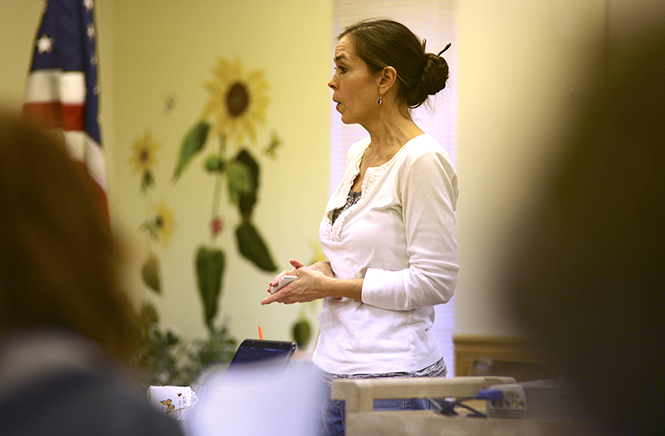Portage county tree sales down in slow economy
Lynn Vogel, coordinator of the annual Portage County tree sale, teaches a workshop at the Soil and Water Conservation District facility in Ravenna on Thursday, Feb. 28. Since the economy has lowered, the annual sale has seen an effect with less orders than usual. Photo by Jenna Watson.
March 12, 2013
Pulling in customers from across Ohio and some neighboring states, Portage County’s tree sale has earned quite a following, but the slow economy has forced them to trim back their program.
Operated by the Soil and Water Conservation District of Portage County, the tree sale is an annual program where people can purchase various types of trees, shrubs and flowers.
The tree sale is part of an effort by the conservation district to promote soil stabilization and fertility. These sales are held in nearly every county in nearly every state, Lynn Vogel, coordinator for the tree sale, explained.
The conservation district itself is a descendant of the Civilian Conservation Corps, a public relief program within President Franklin Roosevelt’s New Deal, Vogel explained.
“Each county or each district would run a tree sale the way they need it,” Vogel said. “In Southeast Ohio it’s more like wildlife packets, because that’s what they are trying to promote, that’s what sells and that’s what people want.”
In the Portage County area, the tree sale specializes in trees and shrubs that are more suited for an urban and suburban setting. These include plants that can break through compressed soil and won’t destroy sidewalks, Vogel explained.
In recent years, however, a shaky economy has taken a bite out of the tree sale’s customer base.
Vogel said the Portage County Tree Sale has seen a 25 percent decrease in the number of customer’s ordering through their program.
Though the number of customers has decreased, the size of the orders for those remaining customers has increased, Vogel said.
“We used to have 500 or so customers, each with a single $12 or $16 item,” Vogel said. “Now we see fewer customers, but those customers are buying five or six different items.”
“I never buy just one thing,” Dee Burdette, an occasional customer of the tree sale for more than 20 years, said. “I like to buy a variety.”
Burdette said the economy has not hindered her desire to purchase plants from the tree sale and plans to continue for the foreseeable future.
Nadine Hawkins, another customer of the tree sale, said the economy has affected neither her love of gardening nor her intentions to purchase a variety of plants from the tree sale.
“My husband and I are fortunate enough to be financially sound,” Hawkins said. “But, I suppose if one were to lose their job, it would be a luxury that you would cut.”
The decrease in sales has led to cuts in the amount of product available. Most of what is offered is now reserved by pre-order, Vogel said.
“We usually spend about $22,000 on product,” Vogel said. “But in recent years, it’s been getting us less.”
In recent years, food-bearing plants have become the number one seller, followed closely by plants meant to drawn in wildlife, Vogel explained.
Contact Michael Jermann at [email protected].
























